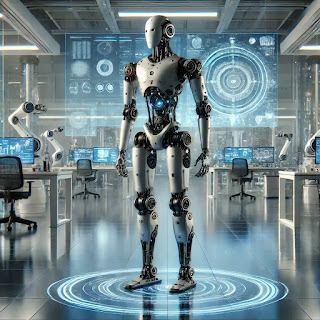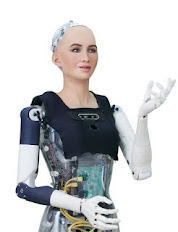Humanoid Robots / Androids: A 2025+ Business & Investment Report
1. Executive Summary
The humanoid-robot (or “android”) sector has moved from futuristic demonstration projects into serious R&D and early-stage commercialization. Continuous improvements in artificial intelligence, battery technology, and materials science have created a convergent point where mass production is on the horizon. This report outlines the key players, potential use cases, market drivers, and financial snapshots of the publicly traded companies most involved in developing humanoid robots.
2. Leading Companies (Ranked by Commercial Readiness & Technological Progress)
Tesla (NASDAQ: TSLA)
- Flagship Robot: Tesla Bot (“Optimus”)
- Why #1? Strong manufacturing track record, advanced battery expertise, and vocal commitment from Tesla’s leadership to deploy humanoid robots in industrial environments. The company’s large AI/Autopilot team provides synergy for real-time control and perception.
Boston Dynamics (Majority-Owned by Hyundai Motor Group, KRX: 005380)
- Flagship Robot: Atlas
- Why #2? Boston Dynamics leads in agility and mobility for humanoid robots. However, historically, they have been slow to commercialize. Hyundai’s ownership could accelerate production capabilities—yet their path to mass production remains more cautious.
Xiaomi (HKEX: 1810)
- Flagship Robot: CyberOne (prototype)
- Why #3? Xiaomi’s deep roots in consumer electronics and its extensive supply chain might allow it to scale quickly if (and when) it decides to commercialize CyberOne. However, the robot remains in conceptual stages, indicating a longer timeline.
SoftBank Robotics (Subsidiary of SoftBank Group, TYO: 9984)
- Key Robots: Pepper, NAO (social robots)
- Why #4? Although SoftBank’s Pepper and NAO are not full humanoids on par with Atlas or Optimus, SoftBank has experience in producing robots at scale. With the right pivot, the group could expand into more advanced humanoid platforms.
Others (Privately Held / Early-Stage)
- Engineered Arts (Ameca)
- Hanson Robotics (Sophia)
- Apptronik (Apollo)
These companies are developing sophisticated platforms but remain private or in earlier phases of commercialization. While they showcase impressive technology, they are not directly open to public market investment (as of early 2025).
3. Most Promising Mass Production Prospects
Tesla
- Production Advantage: Proven global factory network (in the U.S., China, Germany, etc.), advanced supply chain management, and battery manufacturing expertise.
- Stated Goal: Elon Musk has signaled a plan to deploy Tesla Bot first in Tesla factories for routine tasks, potentially scaling to consumer uses.
Hyundai Motor Group (Boston Dynamics)
- Production Advantage: A major automotive manufacturer with strong industrial capabilities.
- Potential: Could pivot from R&D to mass production if a clear commercial application is identified (e.g., manufacturing, logistics, healthcare).
Xiaomi
- Production Advantage: Known for producing high volumes of cost-competitive consumer electronics.
- Potential: If Xiaomi invests heavily into robotics, it could leverage existing electronics and hardware supply chains, but the path to a robust humanoid is still nascent.
4. Use Cases for Humanoid Robots
Industrial & Manufacturing
- Repetitive / Hazardous Tasks: Welding, assembly, material handling in factories.
- 24/7 Operation: Potential to run around the clock with proper maintenance, reducing costs.
Logistics & Warehousing
- Picking and Packing: Tasks that require human-like mobility and dexterity.
- Automated Inventory Checks: Vision-guided robots can navigate aisles and catalog products.
Service & Hospitality
- Customer Interaction: Reception, information desks, basic concierge tasks.
- Entertainment: Theme parks, advertising, or brand engagement.
Healthcare & Elder Care (Longer-Term)
- Patient Assistance: Helping move patients, assist nurses, or provide companionship.
- Household Tasks: Potentially assisting the elderly or disabled with daily living activities.
Research & Education
- Human-Robot Interaction: Universities and labs exploring advanced AI, robotics, and ethics.
- Demonstration Platforms: Showcases for next-gen robotics in STEM education.
5. Why This Market Is Worth Pursuing
Rising Labor Costs & Shortages
- Many developed nations face workforce shortages in manufacturing, logistics, and elder care. Humanoid robots can fill labor gaps for routine or physically demanding tasks.
Rapid Advancements in AI
- Large language models, computer vision, and sensor fusion systems enable robots to perceive and act more autonomously, increasing their utility and reducing the need for custom programming.
Cost Reduction from Scale
- As robotics manufacturing matures, component costs (motors, sensors, processors) continue to drop, making the entry price more attractive for businesses seeking automation.
Potential for Wide Adoption
- The concept of a general-purpose robot—capable of multiple tasks—expands far beyond the traditional limitations of fixed industrial robotics.
Investor Appeal
- Robotics is a high-growth, high-visibility sector that often commands premium valuations. Early involvement in leading companies can yield significant returns if mass adoption materializes.
6. Financial Snapshots (Publicly Traded Leaders)
Below are approximate figures and highlights as of Q1 2025. (Historical data from public sources; forward-looking figures are estimates.)
Tesla (NASDAQ: TSLA)
- Market Cap: Often in the range of USD 700–900 billion (fluctuates with market conditions).
- Revenue (Trailing 12 Months): Over USD 120+ billion, primarily from EV sales, energy storage, and services.
- R&D Expenditure: Estimated at ~5-7% of revenue, a portion now directed toward Optimus/Bot development.
- Key Investment Note: Tesla’s robotics initiative is still a small part of total operations, but strategic leadership sees it as a future growth area.
Hyundai Motor Group (KRX: 005380)
- Market Cap: Typically in the range of USD 35–50 billion (converted from KRW), depending on the unit of Hyundai in question (Hyundai Motor Company, Hyundai Mobis, etc.).
- Revenue (Trailing 12 Months): Over USD 100+ billion across all automotive businesses.
- R&D Expenditure: Hyundai invests billions annually in advanced tech; the portion allocated to Boston Dynamics is not separately detailed but is significant.
- Key Investment Note: Boston Dynamics is not yet a large revenue driver but is a high-tech asset for Hyundai’s future robotics ambitions.
Xiaomi (HKEX: 1810)
- Market Cap: Historically in the range of USD 40–60 billion.
- Revenue (Trailing 12 Months): Often exceeding USD 50+ billion, primarily from smartphones, IoT devices, and internet services.
- R&D Expenditure: A significant chunk is directed at electronics and software development; robotics is still a small but potentially growing slice.
- Key Investment Note: Xiaomi’s robotics ambitions are nascent. If CyberOne or future android initiatives mature, Xiaomi could leverage its massive electronics ecosystem for rapid scaling.
SoftBank Group (TYO: 9984)
- Market Cap: Historically in the range of USD 50–70+ billion (exchange-rate dependent).
- Revenue (Trailing 12 Months): Over USD 40+ billion across telecom, investment, and tech holdings.
- R&D & Investment: SoftBank is known more for large-scale tech investments (e.g., Vision Fund) rather than direct R&D. SoftBank Robotics (Pepper, NAO) could expand or pivot with enough internal capital.
- Key Investment Note: SoftBank’s robotics revenues are relatively modest vs. broader group revenues, but there is potential if they decide to scale advanced humanoid platforms.
7. Strategic Outlook & Considerations
Timeline Uncertainties: The gap between a compelling prototype and full-scale mass production can be substantial. Investors should be mindful of potential delays in product readiness, regulatory issues, and demand uncertainties.
Competitive Dynamics: Specialized robotics companies (private or public) may emerge or partner with established manufacturers, posing either competition or M&A opportunities for the market leaders.
Regulatory & Societal Impact: Worker displacement, ethical concerns, and robotics safety standards will shape how fast humanoid robots can be deployed in certain regions or industries.
Partnership Opportunities: Automakers, tech giants, and AI firms may form alliances to spread R&D costs and accelerate time to market.
Market Size: Conservative estimates see the humanoid robot market (and related services) potentially reaching tens of billions of USD in annual revenue by the 2030s, primarily driven by industrial and service robots.
8. Conclusion
Humanoid robots are at a pivotal stage. As of 2025, Tesla leads in potential mass production, Boston Dynamics/Hyundai are top in advanced locomotion and robotics R&D, Xiaomi shows promise with consumer-electronics scale, and SoftBank remains influential as a tech investor and producer of social robots. The sector’s future hinges on bringing production costs down, improving AI-driven autonomy, and successfully identifying (and serving) large-scale commercial applications.
For investors, the opportunity is significant but carries inherent technology, execution, and adoption risks. The potential payoff lies in capturing a slice of a transformative market—one that could redefine labor, service, and industrial operations for decades to come.
Final Note: Monitoring corporate disclosures, investor calls, and prototype demonstrations will be critical to staying informed. As with any emerging technology, the early winners may be those with deep pockets, top-tier engineering, and a clear path to practical use cases.
Related Articles:





















.jpg)

